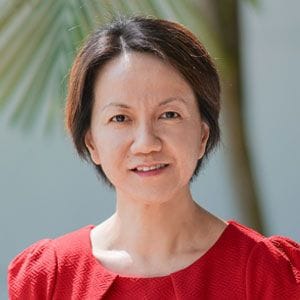In this interview, Professor Xing Yi Ling discusses upcoming challenges in the field of materials science along with new and exciting research we can expect from the eight journals in the ACS Applied Materials portfolio as she begins her new role as Editor-in-Chief.

Dr. Xing Yi Ling is a Professor from Nanyang Technological University, Singapore and Jiangnan University, China. She received her Ph.D. degree in Chemistry from University of Twente, the Netherlands in 2009, and her postdoctoral research at the University of California, Berkeley between 2009-2011. She joined the Chemistry and Biological Chemistry division at Nanyang Technological University in 2011, where she was promoted to professor in 2021. Dr. Ling is a Fellow of The Royal Society of Chemistry and the recipient of numerous awards, including the Singapore National Research Foundation Investigatorship, Nanyang Award for Innovation & Entrepreneurship, L’ORÉAL Singapore for Women in Science National Fellowship, Singapore National Research Foundation Fellowship, IUPAC Prize for Young Chemists, and more.

She currently serves on the editorial boards of Angewandte Chemie, Chemistry of Materials, Nanoscale Horizons, Cell Reports Physical Science, and ChemPlusChem. Her research focuses in using nanotechnology for fundamental studies and applications in environmental, healthcare, and catalysis fields. In particular, she is interested in self-assembling shape-controlled noble metal nanoparticles into superlattices to impart new structure-to-function properties and applications in surface-enhanced Raman scattering (SERS).
Dr. Ling recently shared with us her vision for the ACS Applied Materials portfolio, her proudest accomplishments, and what inspires her research. Read the full conversation below.
What do you see as the biggest challenges and opportunities in the field of materials science and engineering today?
Today, the primary focus in materials science and engineering is tackling the challenges of our times: combating climate change. Despite being in an age of swift technological advancements, the worsening impact of climate change raises serious concerns. Hence, there is a pressing need to develop sustainable and environmental friendly materials that can be easily incorporated in our daily lives to reduce environmental harm.
These challenges present significant opportunities for us, the materials scientists and engineers. I am excited to see our innovation in nanomaterials, energy materials, biomaterials, and intelligent materials are achieving breakthroughs and generating impacts in the fields of environments, energy, healthcare, and technology. I look forward to witnessing more research work successfully transition from research labs to the market, and the growth of international and cross-sector collaborations between academia and industries. Such joint efforts are critical for collectively addressing these global challenges.
What new and exciting things can we expect from the ACS Applied Materials portfolio of journals?
In line with the current challenges and opportunities, the ACS Applied Materials portfolio of journals remain steadfast in our commitment to serve as a platform for knowledge sharing and collaborations. We will continue to promote and publish a wide range of pioneering and robust research findings in the related fields. We aim to feature more studies centered on sustainable and environmentally friendly materials, which are vital in addressing the pressing issues we face today.
Our journals will highlight the latest developments in various material sciences, including nanomaterials (nano, polymer), energy-related materials (energy), and smart materials (biomaterials, electronics, optics, engineering). These rapidly advancing fields are poised to offer groundbreaking solutions in environmental, energy, healthcare fields. The portfolio will explore not just the scientific and technical aspects of these materials but also their practical applications.
This year, our focus will extend to outreach, campus events, and conferences, so that we can engage directly with authors, reviewers, colleagues, and friends worldwide. To me, it is crucial for us to gather diverse viewpoints from both academia and industry globally, to listen to our audience, and to shape the future directions of our Applied Materials portfolio.
What new areas of research are you looking forward to seeing published in the ACS Applied Materials portfolio of journals?
I am looking forward to the continuous advancement in energy storage, upcycling of plastics, and materials designed for harsh environments. The progression in developing advanced materials for batteries and solar photovoltaic technologies is particularly promising. Furthermore, the role of machine learning and AI in the discovery and analysis of new materials is a field I anticipate will see significant advancements and yield revolutionary outcomes. I am also enthusiastic about the research in sustainable materials and upcycling techniques that aim to minimize environmental impacts. Regarding materials for extreme environments, we are likely to see the emergence of high-performance aerogels capable of enduring exceptionally challenging conditions, such as extreme temperature ranges and high levels of radiation.
What accomplishment are you most proud of?
My proudest achievement would be the application of my fundamental research to create health-oriented solutions. Our team collaborated with KK Hospital in Singapore to develop a rapid test based on our surface-enhanced Raman scattering (SERS) research that can detect metabolites associated with miscarriage in pregnant women's urine samples. This test can assess the risk of threatened miscarriage in less than 30 minutes with just a drop of urine.
During the pandemic, to meet the global pressing demand for quicker, less invasive COVID-19 testing methods, our research group partnered with Singapore’s National Centre for Infectious Diseases, and our colleagues in medical school to create a SERS-based breathalyzer, TracieX. This device can accurately identify COVID-19 in individuals from a single breath within less than 2 minutes, boasting a sensitivity and specificity of over 95%. We also expanded our efforts to scale up the production of our research findings to a mass production level and conducted large-scale deployment trials to assess the feasibility of transitioning our laboratory-based SERS research to real-world applications. From a wider perspective, the breathalyzer project represents a significant advancement in employing SERS as a novel, point-of-care diagnostic tool for the biomedical and potential environmental applications.
This experience has strongly reinforced my belief on the vital role scientists can play in responding to societal needs. Throughout the entire project, we worked with experts across a wide range of fields, from physicians, chemists, biologists, physicists, materials scientists, engineers, computer scientists. It highlighted the value of working as a team in tackling the challenges faced in the project, and the significance of collaboration and teamwork. It also taught us the importance of persistence and adaptability in transitioning technology from research to applications. This requires not only scientific expertise but also resilience and a readiness to adapt and learn.
Ultimately, this journey has highlighted the multifaceted role of scientists today—as mentors, innovators, and problem-solvers, actively bridging the gap between laboratory research and real-world applications.
How do you spend your “free” time? Any hobbies?
During my free time, I like going on extended hikes in the mountains. Hiking and venturing into the outdoors are a way for me to stay physically fit, to unplug, and to recharge myself, all while appreciating the beauty of our surroundings.